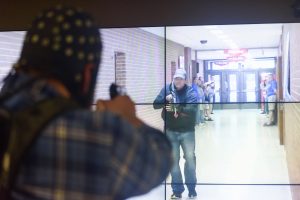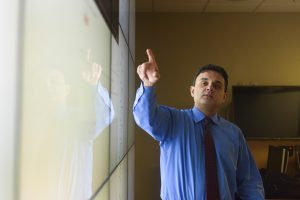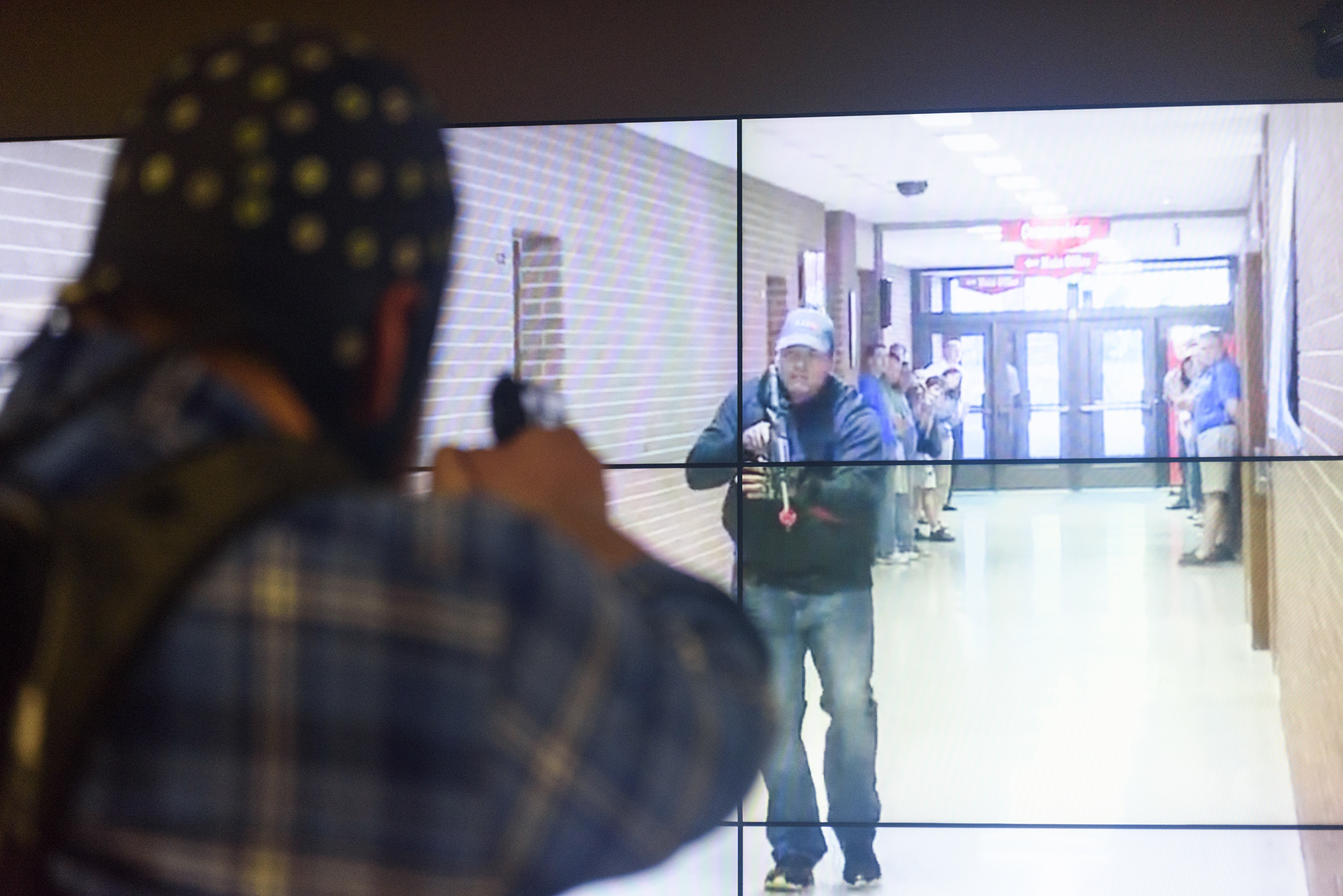
University of Alabama researchers are using a novel approach to learn how police officers react to “shoot, don’t shoot” situations: measuring brain waves during virtual reality police training.
For the past year, Drs. Rick Houser (counselor education), Dan Fonseca (engineering) and Ryan Cook (clinical mental health counseling) have used a mobile electroencephalogram, or EEG, amplifier to measure the brain activity of three law enforcement officers to determine which regions of the brain are active during simulations of potentially high-threat situations.
Preliminary EEG findings, combined with an algorithm used to calculate the sources within the brain, show that one of the five brain waves, in this case the “beta” wave most often associated with thinking, has the highest activity in certain brain regions.
“Preliminary analyses show that officers may activate more beta or thinking brain waves in the right temporal-parietal junction in making decisions associated with responding to high threat situations,” Houser said. “The right temporal-parietal junction is associated with predicting intentions of others, consistent with a major theory in psychology – ‘Theory of Mind.’
“An officer who is able to understand the intentions of others may be more effective in making these high decisions and consequently lower the risk of shooting a community member, particularly those who are unarmed or an accidental shooting.”
The researchers also measure the effectiveness of verbal commands used to de-escalate situations. They note the commands and the time as it relates to the EEG and rely on two seasoned officers to evaluate the responses and establish reliability.
Per terms of the agreement between the researchers and the law enforcement agency, the researchers cannot reveal the identities of the officers participating in the study nor the agency to which they’re attached. Data is collected at the law enforcement agency, which owns and uses the VR simulator in existing training procedures.
Houser, Fonseca and Cook have additional data to analyze, but they hope to secure funding to continue the research at a larger scale, which would yield a larger sample size and eventually see them acquire the space and technology to conduct training sessions on campus.
While that process unfolds, the findings can create a meaningful dialogue rooted in scientific data, Cook said.
“There’s a disconnect between researchers and what happens in the real world,” Cook said. “One of the criticisms is that, too often, research doesn’t have applications, but this is the perfect example of research informing community practices, and what’s happening in the real world informing research. What more impactful way can we do that than to shape the way officers interact with members of their communities?”
Houser and Fonseca had collaborated previously on several projects, including the use of neuroscience to study the impact of low current brain stimulation to promote students’ math performance in pre-calculus. Those studies sparked a question: how can neuroscience, understanding brain activity and identification of corresponding regions of the brain be used to help police officers and first-responders in high-stress situations?

“There are always officers and first-responders who will make decisions under duress that are not typical of most people – we call them ‘MacGyvers,’” Fonseca said. “We don’t know what it is or why, but how they handle that just isn’t typical of people in those fields. We want to encapsulate that knowledge in order to improve training of officers and positively affect the hiring process.”
The conceptualization of focusing on officers and other first responders’ reaction to stress began roughly six months before a recent high-profile shooting of an unarmed citizen – former Ferguson, Missouri police officer Darren Wilson’s shooting of Mike Brown – sparked nationwide dialogue about police training, particularly in “shoot, don’t shoot” scenarios.
And as similar cases in which the use of lethal force have continued to be questioned – both in social and news media — since 2014 — protocols and training curricula have been influenced by a number of methods, including virtual reality, which has seen its research applications grow as believability and pricing of hardware and software have improved.
The trio received an internal grant in 2015 to purchase a mobile EEG unit, which includes a spandex cap with electrodes and the receiver fitted into a backpack to record data. Officers use a 9 mm pistol, which has a recoil action and a laser in place of live rounds.
The simulator tracks each shot and incorporates the exact location of the shot and its outcome. The supervising officer tracks verbal commands of trainees and can alter each encounter relative to the scenario and protocol. Researchers collect the data and also interview officers after each session, which helps them refine their research procedures.
“We talk a great deal about what we learn each time – what the officer was thinking and what they saw that led to the decision they made,” Houser said. “It’s very complex, and I have a much greater appreciation and understanding for the difficulty of the job.”
Ultimately, the researchers would like to see the officers enhance their ability to understand and predict the intentions of others, based on “Theory of Mind.”
Additionally, researchers hope to one day stimulate, through low current brain stimulation, the different regions of the brain that are commonly active during these encounters through transcranial direct stimulation, which they’ve used in other studies.
Contact
David Miller, UA media relations, 205/348-0825, david.c.miller@ua.edu
Source
Dr. Rick Houser, 205/348-0823, rahouser@ua.edu
